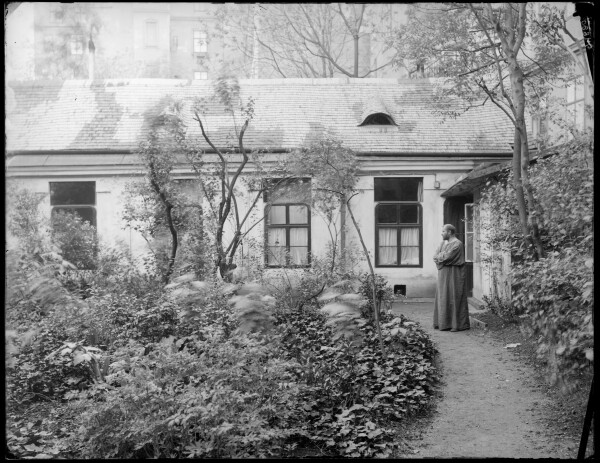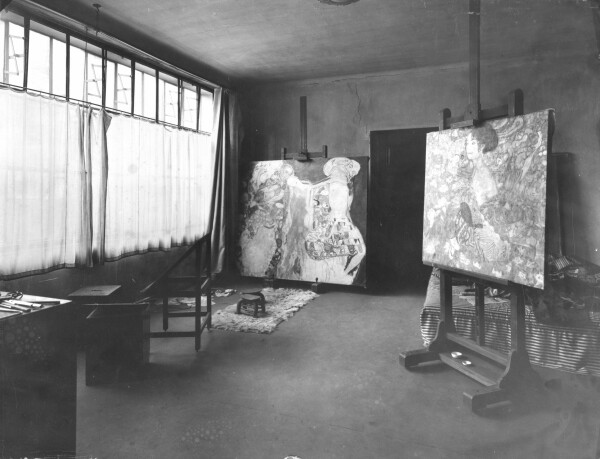Moriz Nähr

Self-portrait of Moriz Nähr, around 1890
© Klimt Foundation, Vienna

Moriz Nähr: Forest Interior, around 1890
© Klimt Foundation, Vienna

Moriz Nähr: Gustav Klimt with a cat in front of his studio in Josefstädter Straße, May 1911, Klimt Foundation
© Klimt Foundation, Vienna

Moriz Nähr: Gustav Klimt in the backyard garden of his studio in Josefstädter Straße, May 1911, Österreichische Nationalbibliothek, Bildarchiv und Grafiksammlung
© Picture Archives and Graphics Department, Austrian National Library

Moriz Nähr: Gustav Klimt's workshop in Feldmühlgasse, presumably 1917, Österreichische Nationalbibliothek, Bildarchiv und Grafiksammlung
© Picture Archives and Graphics Department, Austrian National Library
The manifold oeuvre of the Viennese photographer Moriz Nähr encompasses numerous motifs and styles – including portraits, genre scenes, city views, landscapes and pictures of architecture and interiors – and was greatly influenced by his ties to Gustav Klimt, the Vienna Secession, the House of Habsburg and the Wittgenstein family.
Moriz Nähr was born in Vienna on 4 August 1859 and grew up in humble circumstances. He studied painting at the Imperial-Royal School of Arts and Crafts for three semesters from 1875, where he met Maximilian Lenz, who became a close personal friend. He did not graduate but instead became an apprentice to his older brother Karl, a photographer in Schemnitz, Hungary (now Banská Štiavnica, Slovakia) in 1877. After Karl’s sudden death from tuberculosis, Nähr returned to Vienna the following year. He attended Christian Griepenkerl’s Drawing and Painting Class at the Vienna Academy as a guest student for two semesters.
Nähr subsequently made a name for himself as a photographer and took pictures of landscapes and city views from 1890. Without formal commissions, he photographed architecture and genre scenes during his walks in the city, documenting changes in the urban landscape, such as the channelization of the Wien river, and capturing motifs that were highly unconventional for the time, such as scenes from the Naschmarkt. Nähr presented his landscape and genre studies for the first time at the “Internationale Ausstellung künstlerischer Photographien” [“International Exhibition of Artistic Photographs”] in 1891, which was organized by the Club of Viennese Amateur Photographers (later Camera-Club) at the Imperial-Royal Museum of Art and Industry. The organizational structures of amateur associations and exhibition opportunities in Vienna were well developed; Nähr became a member of the Photographic Society in 1893 and presented his works at exhibitions in Austria and abroad.
As a member of the Hagen Society, a loose association of artists, he captured the group’s bohemian self-staging at meetings and functions such as masked balls and artists’ gatherings and built an extensive web of social connections. Through socializing with Vienna’s high nobility, he gained commissions from the Wittgenstein and Mautner-Markhof families, which not only secured his financial subsistence but also resulted in decade-long friendships and ties to avant-garde artists’ movements.
He became the photographic chronicler of the Wittgenstein family, portrayed the members of the House of Habsburg from 1897 and from the early 1890s and took portraits of Emperor Franz Joseph I during the imperial hunt in Archduke Friedrich's hunting grounds in Bellye in 1897, and was even appointed Archducal Chamber Photographer by the heir to the throne Franz Ferdinand in 1908.
Nähr and Klimt
Nähr was exposed to intense Modernist developments in art in Vienna around 1900. The interrelations of painting and photography led to new image strategies, especially in the Vienna Secession, founded in 1897. It is presumed that Nähr first met Gustav Klimt, the association’s first president, during his studies at the Vienna School of Arts and Crafts, which Klimt attended from 1876. One of Klimt’s classmates in the preparatory class of Professor Ferdinand Laufberger was Nähr’s close friend Maximilian Lenz, also a founding member of the Secession, who was acquainted with Franz Matsch since his childhood, as both had lived in the same house at Josefstädter Straße 23. Matsch and the Klimt brothers moved into their backyard studio next door, at Josefstädter Straße 21, in 1890. Klimt and Nähr had thus been personally connected for many years when Nähr became the official photographer of reproductions for the Secession and began capturing the innovative staging of their exhibitions for the magazine Ver Sacrum. Furthermore, he photographed Klimt’s studios on Josefstädter Straße (1911) and on Feldmühlgasse (1917/18) as well as his paintings. He also created several portrait series. As Klimt’s personal photographer, he was often able to document the artist’s paintings immediately after they had been completed. Since Klimt frequently reworked his paintings before their final completion and had them photographed individually in the context of exhibitions or for purposes of reproduction, Nähr’s pictures have contributed significantly to the documentation of the genesis of Klimt’s works.
After 1900, Moriz Nähr’s photographic oeuvre focused increasingly on interiors, portraits and reproductions. In 1907 he created the well-known series of portraits of Gustav Mahler, then director of the Vienna Court Opera, whom Nähr photographed in the loggia of the opera. In 1908, he documented the exhibition halls and works of art of the “Kunstschau Wien.” On 8 July of the following year, he created a series of portraits of Klimt at the “Internationale Kunstschau.” Klimt reported to Emilie Flöge, who was staying in Kammer on the Attersee at the time:
“[…] was photographed this morning by Nähr – at the Kunstschau – am curious!”
In 1912, Nähr was among the founding members of the Austrian Werkbund. A few years later – in the early 1920s – he photographed the philosopher Ludwig Wittgenstein and his sisters Hermine, Helene and Margarethe. He combined their individual portraits to create a “composite photograph,” intended to illustrate the concept of “family likeness” in Ludwig Wittgenstein’s Philosophical Investigations. During the same time he also documented the Stonborough-Wittgenstein Palace (at Kundmanngasse 19), approaching New Objectivity and “New Vision” in his architectural photographs.
By 1937 he had retired from his professional activities. Only a few weeks before his death in 1945, he married Ludmilla Waas, who had been his life partner for decades. Moriz Nähr died in Vienna on 29 June 1945.
Throughout his life, Nähr did not have a traditional photo studio, but used his own workshop at his apartment. He moved repeatedly within Vienna-Neubau, 7th District; his known addresses include Neustiftgasse 11, Sigmundsgasse 5, Burggasse 33 and Siebensterngasse 30. He primarily worked with large plate cameras (18 x 24 cm) and Petzval portrait lenses. He used various processes (especially gelatin silver prints, matte collodion papers, pigment prints) to produce prints of the highest perfection, which he authenticated with his signature, an embossed stamp or a photographer’s stamp. The largest collections of glass plate negatives and original prints are preserved at the Klimt Foundation, at the picture archives of the Austrian National Library and at the Wien Museum.
Literature and sources
- Uwe Schögl, Hans-Peter Wipplinger (Hg.): Moriz Nähr. Fotograf der Wiener Moderne / Photographer of Viennese Modernism, Ausst.-Kat., Leopold Museum (Vienna), 24.08.2018–29.10.2018, Vienna - Cologne 2018.
- Uwe Schögl: Moriz Nähr and the Vienna Secession. Interrelationship between Photography and Painting, in: PhotoResearcher, Nummer 31 (2019), S. 122-133.
- Elisabeth Dutz: Moriz Nähr. Die Biografie, in: Uwe Schögl, Sandra Tretter und Peter Weinhäupl für die Klimt-Foundation (Hg.): Moriz Nähr (1859–1945). Fotograf für Habsburg, Klimt und Wittgenstein. Catalogue Raisonné, Wien (2021). www.moriz-naehr.com (05/22/2022).
- Andreas Gruber: Das Wittgenstein-Kompositporträt Reconstructed, in: Uwe Schögl, Sandra Tretter und Peter Weinhäupl für die Klimt-Foundation (Hg.): Moriz Nähr (1859–1945). Fotograf für Habsburg, Klimt und Wittgenstein. Catalogue Raisonné, Wien (2021). www.moriz-naehr.com (05/22/2022).
- Markus Kristan: Nur »kristallisierter Putz«? Moriz Nähr und die Supraportenreliefs Josef Hoffmanns in der »Beethoven-Ausstellung« in der Wiener Secession 1902, in: Uwe Schögl, Sandra Tretter und Peter Weinhäupl für die Klimt-Foundation (Hg.): Moriz Nähr (1859–1945). Fotograf für Habsburg, Klimt und Wittgenstein. Catalogue Raisonné, Wien (2021). www.moriz-naehr.com (05/22/2022).
- Photographische Correspondenz, 28. Jg., Nummer 369 (1891), S. 300.
- Brief von Gustav Klimt an Franz Hancke (um 1900). bsb00134525.
- Ansichtskarte von Gustav Klimt in Wien an Emilie Flöge in Kammer am Attersee, 3. Karte (Nachmittag) (08.07.1909). RL 2736, .

